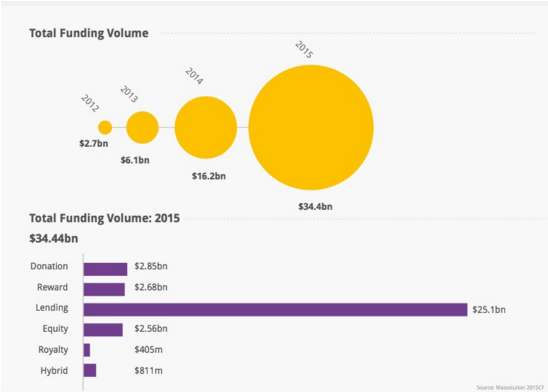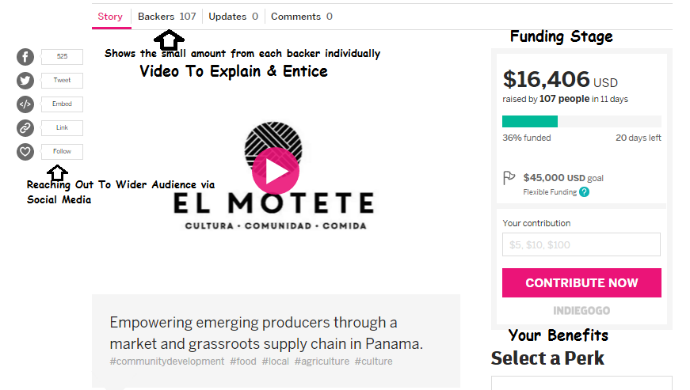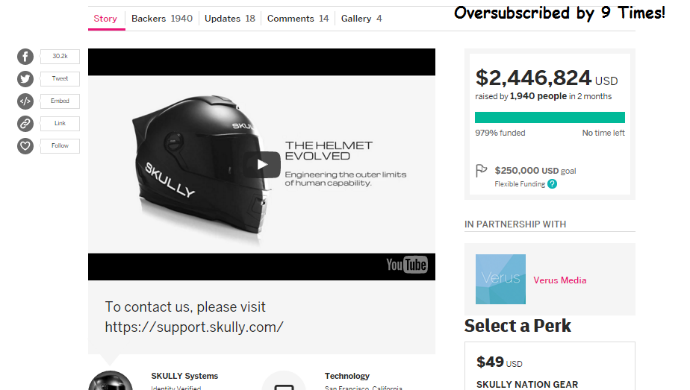Appeal of reward-based crowdfunding — Kickstarter and Indiegogo
The allure of crowdfunding is that it gives you the satisfaction that you provided the financial conditions for artwork to go from conceptualisation all the way to completion
Crowdfunding is a rapidly growing modern industry worth US$34 billion in 2015, and reward crowdfunding has US$2.68 billion share in it built on a century old patronage model.
Kickstarter and Indiegogo are introduced with their own pricing and success stories. All are market leaders but Kickstarter is much more successful.
Read on to find out the appeal of reward crowdfunding.
Modern viable concept — crowdfunding
Crowdfunding is essentially a modern concept that is only made viable with advances in technology that made it affordable for the masses to gain access to technology through laptops and smart phones. The advances of a smart phone points to this tremendous achievement.
According to a Deloitte report, one smartphone produced in 2014 has the same functions as 17 devices produced in 1991.

The widespread availability of Internet technology allowed the masses to participate in various activities and financing would be one important consideration. This is collectively known as crowdfunding.
Globally crowdfunding had been rising quite spectacularly. It raised US$6.1 billion in 2013 to US$16.2 billion in 2014 (167 per cent growth) to US$34.4 billion in 2015, according to Massolution.

Source: Symbid
As we can see, the bulk of the money actually goes to lending platforms (e.g. Lending Club and Capital Match), but reward has quite a decent share at US$2.68 billion. That shall be the focus of our article today.
Reward-based crowdfunding
While lending, equity and donation may be straightforward, it is not so for reward crowdfunding. Hence I would first define what is reward-based crowdfunding by contrast.
Donation crowdfunding means that you give out money without expecting anything in return.
Lending crowdfunding means that you give out money with the expectations that you will get back more money than you give out over time.
For reward-based crowdfunding, you give out money with the expectation of getting an awesome product that you funded in the future. It might be the awesome bicycle, video game or even art work. They normally cover a product that is under development which requires funds for its completion.
The allure of crowdfunding is that it gives you the satisfaction that you provided the financial conditions for artwork to go from conceptualisation all the way to completion. You are also one of the first few people in the world to actually get to used it and we will be covering some of the awesome products that came out of crowdfunding.
Patronage for the masses
This form of funding actually had its roots from the arts patronage model where artists would go to wealthy audiences to fund their arts creation. The model of patronage started in 11 century Florence (Italy) and spread throughout Europe. Galileo benefited from the patronage of the Grand Duke of Tuscany in the 1600s.
Hence this form of patronage is not something new. It is something which had been transformed by technology that allowed ordinary citizen to support their artists or inventors with modest sum of money. What used to the exclusive domain of the rich and wealthy is now open to the public.
Today the most innovative economy in the world, the US, is home to two of the most successful reward crowdfunding platforms. They are New York-based Kickstarter and San Francisco-based Indiegogo.
Profile of Kickstarter
Kickstarter was founded in 2009 and organised as a Benefit Corporation in 2015. This means that it weighs the social impact of its activities alongside its impulse to make profits for its shareholders. Its employees are given time off to pursue their own creative projects and a benefit report is published annually to measure the results of its effect to society.
The company owes its success on its ability to attract a wide section of society to pay for the development cost of new products and art work. This corporate alignment would likely greater approval from the public to support artists and entrepreneur on its platform.
Currently Kickstarter supports the following sections — Art, comics, crafts, dance, design, fashion, film & video, food, games, journalism, music, photography, publishing, technology and theatre.
The creators of this art work would create a video to tell a wide audience of what they intend to produce and their track record would be published for all to consider.

Source: Kickstarter
For example, under the Games category, Kickstarter is currently recommending board game lovers to back this creator called Grail Games. They had a solid track record of six successful games being created with just 35 backers.
Today, they are launching their 7th game and with Kickstarter endorsement, they had an impressive 207 backers with 23 days to date. They will only get their money if they can raise AU$$15,000. They are from Australia and they chose to get funded in the US due to the mature market for crowdfunding there.
Campaign contributors can pledge a variety of funds from AU$1-180 and more. For AU$1, you can get updates from Grail Games about the progress of the game development. So you can be the one of the first to buy it. For AU$180, you get four copies of the game which includes shipping cost to selected countries. They get it at a discount from retail price and also before the rest of the world. For board game lovers, this is attractive.
Profile of Indiegogo
The main competitor to Kickstarter would be Indiegogo. Indiegogo was launched in 2009 in San Francisco but it has not chosen to be reorganised as a Benefit Corporation. The slight difference is that Indiegogo has a technology orientation and it has built a stronger base for new technology products.
It also allows fund raisers to continue to raise fund after their successful campaign with its InDemand platform. This is not restricted to campaigns raised from Indiegogo. In addition, it has a donation crowdfunding subsidiary called Generosity.
Indiegogo organised its reward crowdfunding into the following categories — Tech, film, small business, community, music, education, design, environment, health, and video web.

Source: Indiegogo
The picture above shows how Indiegogo presents each fund raising activity. In this instance, EL Motete is a small business in Panama that is creating a marketplace for poor Panama farmers. They aim to raise US$45,000 where US$15,000 each will be spent on building the physical market and stocking (buy food from local farmers). US$10,000 for equipment (e.g. Fridge and storage space) and US$2500 each for legal and utilities fees.
As a contributor, you won’t be getting a share of the profit (this is not equity crowdfunding) but you will get specialty Panama products instead. For US$5, you will get mentioned on their website and for US$100 and shipping fee you will get a Panama produced Chacara bag. It is for you to decide if this is worth it.
If there are ladies who are willing to pay US$3,000 for a Chanel bag, there will be people that are willing to pay US$100 for a hand-made and unique Chacara bag. Value is in the eye of the beholder.
Pricing
Both Indiegogo and Kickstarter make their living by extracting 5 per cent of the fund raised. This excludes the PayPal or Stripe or Credit Card fees that may be charged on top of it. This can add another 3-5 per cent. This is for funds that are raised in the US. If the funds had to be remitted overseas, then you will have to incur another layer of remittance.
For a fund raiser that would require US$100,000 in working capital, he would need to raise US$110,000 on the website. Kickstarter has a strict all or nothing funding policy. In other words, if you wanted to raise US$110,000 and backers only contribute US$109,999 then you get nothing. The rationale is that you are not likely to be successful if you cannot get full financial backing and successful campaign can get free word of mouth pre-launch marketing.
For Indiegogo, they have fixed and flexible campaign. Fixed campaign is similar to Kickstarter all or nothing policy. Flexible just means that you can keep whatever amount you raised on the assumption that you know that it is sufficient to get your product into working condition.
No fees are charged for unsuccessful campaign for both platforms.
Success stories
Both platforms are successful platforms that had been around for the past seven years and they have spawned numerous success stories and awesome products. You can look at the top 7 Indiegogo success stories here. For this article, I am going to highlight the awesome smart motorcycle helmet. The creators aimed for US$250,000 of fund raising but they got over US$2.4 million instead.

Source: Indiegogo
Skully created this awesome helmet that is light and equipped with rear view cameras. In addition, it streams music and has blue-tooth, Internet connection, handsfree calling and scratch resistant visor. If this sounds like it came right out of a sci-fi fantasy movie, this is the exact reason for its popularity. Skully made this sci-fi movie a reality. If you pay US$499 for it, you will get the helmet (which was delivered in July 2015). US$49 gets you a Skully t-shirt.
For Kickstarter, you can look at the most funded campaigns here. While there are numerous success stories, I would like to highlight Pebble watch. Everyone is familiar with Apple Watch but Pebble has a superior wearable smart watch.
Source: Kickstarter
Pebble asked for US$500,000 but it received over US$20 million instead. The reason for its popularity is simple. It has longer battery life, better features and it works across platforms like Apple, Samsung and other smartphones. You wouldn’t find an Apple Watch that can work with Samsung Galaxy phone.
Conclusion
The appeal of benefits crowdfunding should be clear at this point. This is why it is a US$2.85 billion industry in 2015. Kickstarter raised US$2.16 billion at the point of writing and with their 5 per cent commission, their shareholders are millionaires. Indiegogo did not reveal their statistics but this TechCrunch report shows that for every US$6 Kickstarter raise, Indiegogo would raise US$1.
In other words, Kickstarter is much more successful than its nearest rival Indiegogo. This is very much like the relationship between peer-to-peer lending leader Lending Club and its nearest rival Prosper. The leader outpace its nearest competitor significantly.
Lastly, there is one other notable Kickstarter product which I must mention. The virtual reality goggles Oculus Rift started as Kickstarter project and raised US$2.4 million despite asking for only US$250,000 in 2012. It was later acquired by Facebook for US$2 billion in March 2014 and Mark Zuckerberg has awesome plans to expand it beyond gaming.
If you have the time, do look around at these two websites. You might find some amazing products and be the first in the world to own them. Thanks for reading.
The views expressed here are of the author’s, and e27 may not necessarily subscribe to them. e27 invites members from Asia’s tech industry and startup community to share their honest opinions and expert knowledge with our readers. If you are interested in sharing your point of view, please send us an email at sainul[at]e27[dot]co.
Image Credit: Shutterstock
The post Appeal of reward-based crowdfunding — Kickstarter and Indiegogo appeared first on e27.


